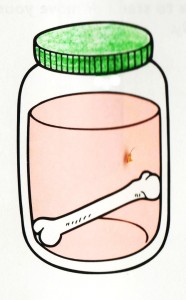The hard part of bone is made up mainly of the chemical calcium phosphate. Fibers called collagen (a protein) run through the calcium phosphate. The calcium phosphate gives bones firmness and strength, and collagen gives them flexibility. The vinegar reacts with the calcium phosphate, thus removing the calcium from the bone and making it bendable. The less calcium in the bone, the softer and more bendable it becomes. With age, humans lose calcium from their bones causing a condition called osteoporosis (loss of calcium and mass causing porous, easily fractured bones). During space travel, due to weightlessness, humans and animals lose bone calcium and bone mass resembling osteoporosis. The difference is that osteoporosis takes years but in space the changes takes only a few months.
Research done by American astronaut, Mae Jamison, during her space flight had to do with the loss of calcium in bones. Following is an experiment that you can perform to determine for yourself how bones are affected by a loss of calcium.
1. Ask an adult helper to cut as much of the meat as possible off of a cooked chicken leg.
2. Wash the bone in soapy water, and then rinse with fresh water.
3. Try to bend the bone with your fingers. Rate the hardness of the bone using a scale of 1 to 10, with 10 being the hardest.
4. Place the bone in a jar, and then add enough white vinegar to cover the bone. Seal the jar with a lid.
5. After 24 hours, remove the lid, and using the tongs, remove the bone from the jar.
6. Rinse the vinegar off the bone with fresh water.
7. Again test and rate the hardness of the bone as in step 3.
8. Replace the bone in the jar of vinegar and repeat steps 5 through 7 three times.
 |
Human Body |

